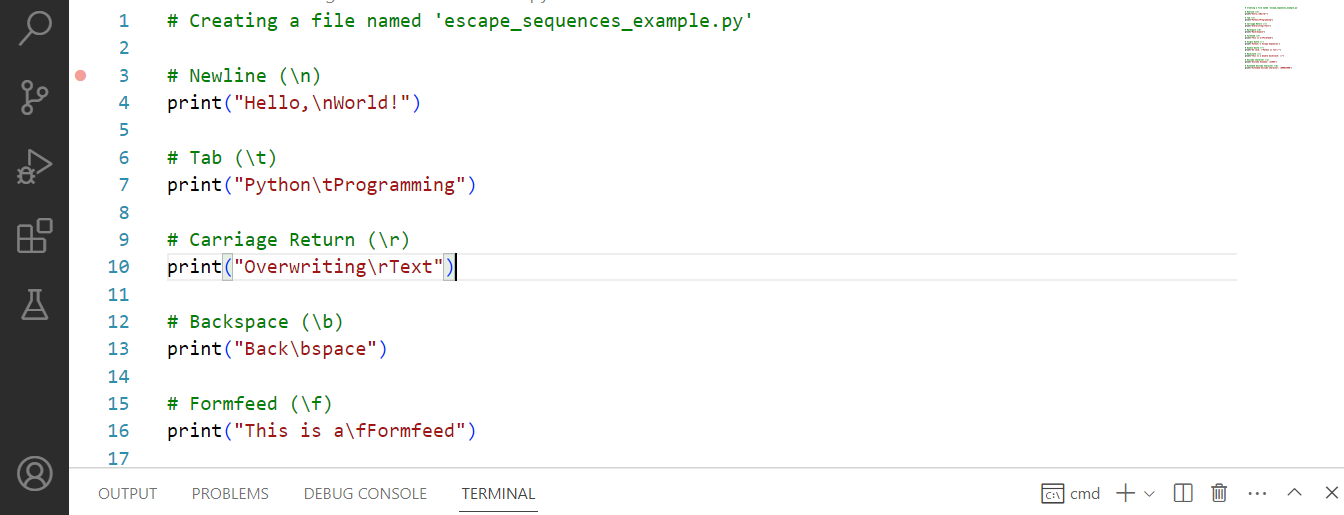Outlines
Python Escape Sequences: A Guide to Handling Special Characters
Python Escape Sequences are essential for managing special characters within strings. These different sequences, denoted by backslashes, encode special characters like newline (\n), tab (\t), or quotes (“) within strings. Learning these different sequences with examples is very important in manipulating text-based data, controlling its formatting, or handling characters that would otherwise be misinterpreted.
Escape sequence will help developers to include different special characters without disrupting the string’s structure. Python escape sequences facilitate programmers to manipulate text effectively, also it will be accurate representation and formatting in various applications, including data processing, and user interfaces.
Python Escape Sequences Characters Purposes
Escape sequences in Python Language are very important for handling special characters inside a string, creating accurate representation without disturbing the string’s structure. They enable the programmer to include characters like quotes (” or ‘), tabs (\t), newlines (\n), and other non-printable or Unicode characters, etc.
Primary purposes of Python escape sequences include
1. Inserting Special Characters: Escape sequences allow the inclusion of unique characters’ inner strings that might in any other case reason parsing problems, including fees (” or ‘), newline characters (n), tabs (t), or backslashes (\).
2. Formatting Text: It can assist in formatting textual content via inserting whitespace characters like tabs or newlines, permitting better clarity or properly based output.
3. To Handle Non-Printable Characters: Escape sequences constitute non-printable characters that are invisible to the consumer, such as the carriage go back (r) or backspace (b), etc.
Four. Unicode Characters: Escape sequences facilitate the inclusion of different Unicode characters the usage of the u or U notation, it permits the illustration of a huge variety of characters beyond the ASCII set.
All Characters List
In Python language, escape sequences start with a backslash \ followed by a character that represents a special sequence.
Examples:
\n – Newline
\t – Tab
\r – Carriage Return
\b – Backspace
\f – Formfeed
‘ – Single Quote
” – Double Quote
\ – Backslash
\uXXXX
\UXXXXXXXX
Python Escape Sequence Characters Examples
|
1 2 3 4 5 6 7 8 9 10 11 12 13 14 15 16 17 18 19 20 21 22 23 24 25 26 27 28 29 30 31 |
# Creating a file named 'escape_sequences_example.py' # Newline (\n) print("jafri,\ncode!") # Tab (\t) print("Python\tProgramming Language") # Carriage Return (\r) print("This is, Overwriting\rText") # Backspace (\b) print("Example for Back\bspace") # Formfeed (\f) print("Hi, This is a\fFormfeed") # Single Quote (\') print('Python Programming\'s Escape Sequences') # Double Quote (\") print("He said, \"Python is fun!\"") # Backslash (\\) print("This is a double backslash: \\") # Unicode Character (\u) print("Unicode Snowman: \u2603") # Extended Unicode Character (\U) print("Extended Unicode Character: \U0001F600") |
You have to run this Python script in your IDE that will display the output demonstrating the usage of various escape sequence characters in strings.

Exercises Related to Python Escape Sequences
Escape sequences are fundamental in Python for managing special characters within strings. These sequences, initiated by a backslash \, enable the inclusion of characters like quotes, tabs, newlines, and other non-printable or Unicode characters.
Escape Sequence Exercises:
Exercise 1: Newline and Tab
Create a string that displays your name on one line and your address on the next line.
Solution:
|
1 2 3 |
name = "John Doe" address = "\t123 Main Street\n\tCityville, XYZ" print(name + "\n" + address) |
Exercise 2: Quote Escaping
Create a string that includes a quote inside it.
Solution:
|
1 2 |
quote = "She said, \"Python is versatile!\"" print(quote) |
Exercise 3: Backslash Usage
Print a string containing a backslash.
Solution:
|
1 2 |
backslash_str = "This is a single backslash: \\" print(backslash_str) |
Exercise 4: Unicode Character
Display a Unicode smiley face (😊) using escape sequences.
Solution:
|
1 2 |
unicode_smiley = "\U0001F60A" print("Unicode Smiley:", unicode_smiley) |
Exercise 5: Carriage Return
Print two lines, one overwriting the other using a carriage return.
Solution:
|
1 2 3 4 5 |
import time print("Loading...", end="", flush=True) time.sleep(2) print("\rLoaded!") |
These exercises aim to reinforce your understanding of Python’s escape sequences, enabling you to practice incorporating special characters within strings effectively.
Conclusion:
In this post, I have shared everything related to the Python escape sequence, now you have to make your practice with the exercises I shared with you. Open your IDE and paste my provided exercises that will help you to understand better. There are many other Python tutorials I have shared with you, which you can follow in the below section.
Would you like to learn?
Resolving Python AssertionError: Steps for Debugging Assertions
15+ Tips to Become A Professional Python Coder
Python Functions: A Step-by-Step Beginner’s Guidelines
If you like this post please share it on social networks such as Facebook, Twitter, and WhatsApp Contact / Groups to spread Python knowledge! And please don’t forget to subscribe to our YouTube channel for more Python Tips and Python video course content.
